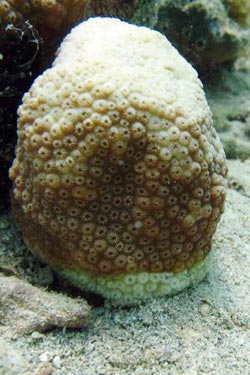Viruses associated with coral epidemic of “white plague”

Coral with white plague<br>
Now one of the possible causes of this growing disease epidemic has been identified – a group of viruses that are known as small, circular, single-strand DNA (or SCSD) viruses. Researchers in the College of Science at Oregon State University say these SCSD viruses are associated with a dramatic increase in the white plague that has erupted in recent decades.
Prior to this, it had been believed that the white plague was caused primarily by bacterial pathogens. Researchers are anxious to learn more about this disease and possible ways to prevent it, because its impact on coral reef health has exploded.
“Twenty years ago you had to look pretty hard to find any occurrences of this disease, and now it’s everywhere,” said Nitzan Soffer, a doctoral student in the Department of Microbiology at OSU and lead author on a new study just published in the International Society for Microbial Ecology. “It moves fast and can wipe out a small coral colony in a few days.
“In recent years the white plague has killed 70-80 percent of some coral reefs,” Soffer said. “There are 20 or more unknown pathogens that affect corals and in the past we’ve too-often overlooked the role of viruses, which sometimes can spread very fast.”
This is one of the first studies to show viral association with a severe disease epidemic, scientists said. It was supported by the National Science Foundation.
Marine wildlife diseases are increasing in prevalence, the researchers pointed out. Reports of non-bleaching coral disease have increased more than 50 times since 1965, and are contributing to declines in coral abundance and cover.
White plague is one of the worst. It causes rapid tissue loss, affects many species of coral, and can cause partial or total colony mortality. Some, but not all types are associated with bacteria. Now it appears that viruses also play a role. Corals with white plague disease have higher viral diversity than their healthy counterparts, the study concluded.
Increasing temperatures that stress corals and make them more vulnerable may be part of the equation, because the disease often appears to be at its worst by the end of summer. Overfishing that allows more algae to grow on corals may help spread pathogens, researchers said, as can pollution caused by sewage outflows in some marine habitats.
Viral infection, by itself, does not necessarily cause major problems, the researchers noted. Many healthy corals are infected with herpes-like viruses that are persistent but not fatal, as in many other vertebrate hosts, including humans.
About the OSU College of Science: As one of the largest academic units at OSU, the College of Science has 14 departments and programs, 13 pre-professional programs, and provides the basic science courses essential to the education of every OSU student. Its faculty are international leaders in scientific research.
MEDIA CONTACT:
David Stauth,
541-737-0787
SOURCE:
Nitzan Soffer
Media Contact
More Information:
http://www.oregonstate.eduAll latest news from the category: Ecology, The Environment and Conservation
This complex theme deals primarily with interactions between organisms and the environmental factors that impact them, but to a greater extent between individual inanimate environmental factors.
innovations-report offers informative reports and articles on topics such as climate protection, landscape conservation, ecological systems, wildlife and nature parks and ecosystem efficiency and balance.
Newest articles

Making diamonds at ambient pressure
Scientists develop novel liquid metal alloy system to synthesize diamond under moderate conditions. Did you know that 99% of synthetic diamonds are currently produced using high-pressure and high-temperature (HPHT) methods?[2]…

Eruption of mega-magnetic star lights up nearby galaxy
Thanks to ESA satellites, an international team including UNIGE researchers has detected a giant eruption coming from a magnetar, an extremely magnetic neutron star. While ESA’s satellite INTEGRAL was observing…

Solving the riddle of the sphingolipids in coronary artery disease
Weill Cornell Medicine investigators have uncovered a way to unleash in blood vessels the protective effects of a type of fat-related molecule known as a sphingolipid, suggesting a promising new…





















